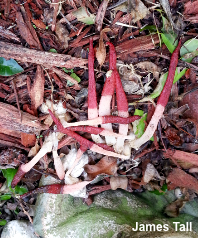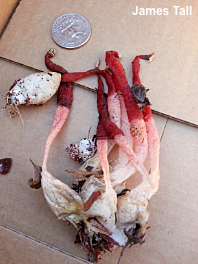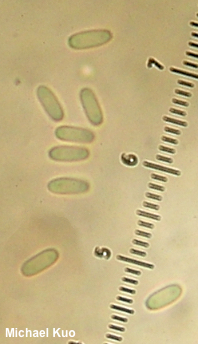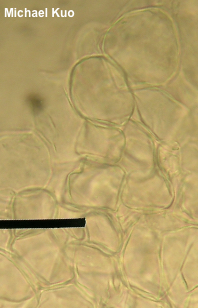| Major Groups > Stinkhorns > Mutinus bambusinus |

|
Mutinus bambusinus [ Basidiomycota > Phallales > Phallaceae > Mutinus . . . ] by Michael Kuo This is a distinctive stinkhorn from the tropics that, like other species of Mutinus, consists of a stem-like structure and no separated cap or head; malodorous, insect-attracting spore slime is spread across the surface of the stem itself. Mutinus bambusinus can be separated from other Mutinus species with a combination of features: it is particularly narrow and pointy; its "spore zone" is dark red underneath the spore slime, and extends for one-half to two-thirds of the stem; its apex is often slime-less, pale, and perforated; and its lower portion is pink to whitish. Mutinus ravenelii is similarly colored (pink below, red under the spore slime) but thicker and less pointy—and its spore zone only takes up one-fourth to one-third of the stem (additionally its range is more northerly and does not appear to overlap). Mutinus argentinus is also similar but is again less pointy, and features a pale orange lower stem surface; its spore zone extends for only about one-third of the fruiting body. It is not recorded from North America. Thanks to Lara Kramer, Nina Peck, and James Tall for documenting, collecting, and preserving Mutinus bambusinus for study; their collections are deposited in The Herbarium of Michael Kuo. Description: Ecology: Saprobic; growing alone or gregariously in gardens, flowerbeds, and cultivated areas—but also appearing in bamboo groves; May through October; tropical in distribution (recorded from Africa, Asia, Australia, South America, Central America, and, in North America, from Florida, Mexico, and Puerto Rico). The illustrated and described collections are from Florida and Guam. Immature Fruiting Body: Usually at least partly submerged in the substrate; a whitish "egg" up to 3 cm high and 2 cm wide; when sliced revealing the stinkhorn-to-be encased in a gelatinous substance. Mature Fruiting Body: 6–10 cm high; 7-12 mm thick at widest point; shaped like a narrowing cylinder that reaches a fairly sharp point at the top; hollow; surface spongy and pocked, pink to nearly white below a wide zone of dark red that extends over roughly the upper half to two-thirds; apex sometimes pink to whitish, often becoming perforated at maturity; when fresh covered with brown spore slime on the red portion; base encased in a white, sacklike volva; attached to thin white rhizomorphs. Odor: Foul and strong while the spore slime is present. Microscopic Features: Spores 3–4.5 x 1–1.5 µm; cylindric; smooth; hyaline or slightly ochraceous in KOH. Sphaerocysts of the pseudostipe 20–55 µm across; irregularly subglobose; walls 1–1.5 µm thick; smooth; hyaline in KOH. Hyphae of the volva cylindric; 1–3 µm wide; smooth; hyaline in KOH; often constricted at the septa and swollen up to 6 µm on either side of the septum; branching; occasionally with digitate projections or with H-like cross bars. Clamp connections not found. REFERENCES: (Zollinger, 1854) E. Fischer, 1886. (Lloyd, 1909; Petch, 1926; Dring & Rose, 1977; Saenz & Nassar, 1982; Hemmes & Desjardin, 2002; Calonge et al., 2005; Hemmes & Desjardin, 2009; Hosaka, 2012; Gogoi & Parkash, 2014; da Silva et al, 2015; Alves & Cortez, 2016.) Herb. Kuo 08091201, 09201201, 07271302. This site contains no information about the edibility or toxicity of mushrooms. |
|
|
Cite this page as: Kuo, M. (2019, November). Mutinus bambusinus. Retrieved from the MushroomExpert.Com Web site: http://www.mushroomexpert.com/mutinus_bambusinus.html © MushroomExpert.Com |






